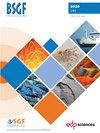Multiphase melting, magma emplacement and P-T-time path in late-collisional context: the Velay example (Massif Central, France)
IF 2.6
3区 地球科学
Q2 GEOSCIENCES, MULTIDISCIPLINARY
引用次数: 35
Abstract
The West European Variscan chain is a remarkable illustration of how partial melting marks out the geodynamic evolution of mountain belt through time. Here, we focus on the Late Carboniferous melting events reported in the southeastern French Massif Central (Velay dome), with emphasis on the modes of partial melting, relationships between partial melting and magma emplacement, transition between the melting episodes and related P-T-t path. Following nappe stacking events under medium pressure/temperature conditions (M1 and M2 events), three melting events are identified in the southern envelope of the Velay dome. A first melting episode (M3 event) occurred within the biotite stability field at 325–315 Ma (T ≈ 720°C and P = 0.5–0.6 GPa). It led to the complete disappearance of muscovite and to the formation of migmatites consisting of biotite ± sillimanite melanosome and of granitic/tonalitic leucosomes depending on protolith composition. It is interpreted as the result of internal heating mainly linked to decay of heat producing elements accumulated in a thickened crust. It resulted in the formation of a partially molten middle crust with decoupling between the lower and upper crust, late-collisional extension and crustal thinning. The second episode of melting (M4 event) occurred at ca. 304 Ma (T 800°C and P 0.4 GPa), synchronously with emplacement of the Velay granites and growth of the dome. It led to the breakdown of biotite and growth of cordierite (locally garnet or tourmaline), with formation of diatexites and heterogeneous granites. This high-T event synchronous with crustal extension is considered to result from intrusion of hot mantle-derived and lower crustal magmas triggering catastrophic melting in the middle crust. This event ends with local retrograde hydrous melting within the stability field of biotite close to the solidus in response to local input of water during temperature drop in the late stage of emplacement of the Velay dome. The last evidence of melting in this area (M5 event) corresponds to emplacement of late granites generated under conditions estimated at ≈850°C and 0.4–0.6 GPa. They may have been generated from melting of specific lithologies triggered by injection of mafic magmas. These granites emplaced in a partly cooled crust (medium-grade conditions). The emplacement age of these granites is not well constrained (305–295 Ma) though they clearly post-date the Velay granites. The melting episodes in the Velay area and generation of granites appear to correspond to the conjunction between (i) the effects of collision-related crust thickening and (ii) those related to slab break off and asthenospheric mantle decompression melting. The driving process is mainly the internal radiogenic heat in a first stage, relayed by the propagation of a thermal anomaly initially located in the lower crust (M3 event), but which subsequently rose to the middle and upper crustal levels through magma transfer (M4 event). Overall, the Velay example is a remarkable illustration of the progressive dehydration and sterilisation of a thickened crustal segment. It documents how large amounts of granitic magmas can be produced at shallow crustal levels in relation to the injection of mantle-derived magmas.晚期碰撞背景下的多阶段熔融、岩浆侵位和p -t时间路径:以法国中部地块Velay为例
西欧瓦利斯坎链是一个很好的例证,说明了部分融化如何标志着山带的地球动力学演变。本文以法国中部地块(Velay dome)东南部晚石炭世的熔融事件为研究对象,重点讨论了部分熔融的模式、部分熔融与岩浆侵位的关系、熔融期的过渡以及相关的P-T-t路径。在中压/温条件下的推覆体叠加事件(M1和M2事件)之后,在Velay穹隆的南包络层确定了三个熔融事件。第一次熔融(M3事件)发生在325 ~ 315 Ma (T≈720℃,P = 0.5 ~ 0.6 GPa)的黑云母稳定场内。它导致白云母完全消失,形成由黑云母±硅线石黑素体和花岗岩/色调白素体组成的混合岩,这取决于原岩的组成。它被解释为内部加热的结果,主要与在增厚的地壳中积累的产热元素的衰变有关。形成了部分熔融的中地壳,下地壳与上地壳分离,后期碰撞伸展,地壳变薄。第二次熔化(M4事件)发生在约304 Ma(温度800°C,温度0.4 GPa),与Velay花岗岩的就位和圆顶的生长同步。它导致黑云母的分解和堇青石(局部石榴石或电气石)的生长,并形成双辉石和非均质花岗岩。这一与地壳伸展同步的高t事件被认为是幔源热岩浆和下地壳热岩浆侵入引发中地壳灾难性熔融的结果。这一事件以靠近固相的黑云母稳定场内的局部逆行水化融化而结束,这是对Velay穹丘就位后期温度下降时局部水输入的响应。该地区最后的熔融证据(M5事件)对应于在约850°C和0.4-0.6 GPa条件下形成的晚期花岗岩就位。它们可能是由镁质岩浆注入引发的特定岩性的熔融而产生的。这些花岗岩位于部分冷却的地壳中(中等等级条件)。虽然这些花岗岩的就位年代明显晚于Velay花岗岩,但它们的就位年代(305-295 Ma)并没有得到很好的限制。Velay地区的熔融事件和花岗岩的生成似乎对应于(i)与碰撞有关的地壳增厚的影响和(ii)与板块断裂和软流圈地幔减压熔融有关的影响。第一阶段的驱动过程主要是内部放射性成因热,由最初位于下地壳的热异常传播(M3事件)传递,随后通过岩浆转移上升到地壳中上层(M4事件)。总的来说,Velay的例子是一个显著的例子,说明了一个增厚的地壳段的逐渐脱水和灭菌。它记录了大量的花岗岩岩浆是如何在地壳浅层产生的,与地幔源岩浆的注入有关。
本文章由计算机程序翻译,如有差异,请以英文原文为准。
求助全文
约1分钟内获得全文
求助全文
来源期刊
CiteScore
5.80
自引率
0.00%
发文量
18
审稿时长
>12 weeks
期刊介绍:
BSGF - Earth Sciences Bulletin publie plusieurs types de contributions :
1. des articles originaux, couvrant tous les champs disciplinaires des Géosciences, à vocation fondamentale mais également à vocation plus appliquée (risques, ressources);
2. des articles de synthèse, faisant le point sur les avancées dans un domaine spécifique des Géosciences, qu''elles soient méthodologiques ou régionales ;
3. des monographies sur la géologie d’une région donnée, assorties d’informations supplémentaires, cartes, coupes, logs, profils sismiques … publiées en ligne en annexe de l’article ;
4. des articles courts de type « express letter » ;
5. des livrets-guides d’excursion (qui suivront le même processus d’examen éditorial que les articles plus classiques) ;
6. des comptes rendus de campagnes à la mer ;
7. des articles de données géodésiques, géophysiques ou géochimiques, pouvant devenir des articles de référence pouvant conduire à des interprétations ultérieures.
BSGF - Earth Sciences Bulletin constitue également un forum pour les discussions entre spécialistes des Sciences de la Terre, de type comment-reply ou autre. Tous les articles publiés, quelle que soit leur forme, seront accessibles sans frais (articles en Open Access) sur le site de la SGF et sur celui de Geosciences World dans la mesure où les auteurs se seront acquittés d’une contribution de (Article Processing Charges – APC) de 300€ pour les membres de la SGF et 500€ pour les non-membres.

 求助内容:
求助内容: 应助结果提醒方式:
应助结果提醒方式:


